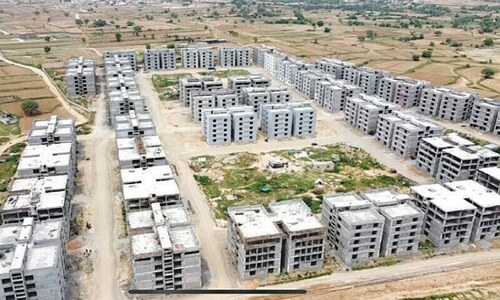Pakistan’s Housing Sector Faces Sharp Slowdown
Pakistan’s housing sector is currently grappling with a significant downturn, characterized by sluggish sales and bookings, a situation exacerbated by escalating inflation, elevated interest rates, and increased property taxes.
Experts warn that without prompt intervention, specifically a government-supported, subsidized housing finance program facilitated through commercial banks, the sector is vulnerable to prolonged stagnation and a further decline in buyer confidence.
A study by the House Building Finance Corporation Limited (HBFC) indicates that the present construction cost is approximately Rs 4,300 per square foot. Consequently, even a modest 1,000 sq. ft home, valued at Rs 4.3 million, would necessitate a monthly mortgage installment of Rs 57,139 at a 15 percent interest rate. This figure substantially exceeds the Rs 9,165 that low-income individuals can allocate to housing based on affordability benchmarks.
Even with an initial 30 percent down payment of Rs 1.3 million, the remaining loan balance of Rs 3 million would still demand a monthly payment of Rs 39,997, considerably surpassing their total monthly income, the study highlighted.
The study also emphasized the need for provincial administrations to proactively enhance housing quality and affordability for vulnerable populations, who have been overlooked due to the formal recognition of Katchi Abadis.
As financial resources become available, provincial governments should develop a portfolio of rental properties meeting legal and construction standards, ensuring public housing includes education, healthcare, public transportation, and utilities. According to the study, “A government-backed rental model could uplift millions from slums, providing dignified and secure living conditions. By integrating vital services and drawing from successful international models, Pakistan can establish sustainable urban housing, empowering low-income residents to escape poverty.”
Ibrahim Amin, a real estate valuation consultant, noted that due to high interest rates and continuous property price increases, including surging construction and land expenses, a substantial portion of Pakistan’s population can no longer afford even a small apartment.
He emphasized that numerous residential societies and apartments in major cities remain unsold due to the lack of affordable financing options for the public.
He advocated for a long-term subsidized housing finance scheme to enable individuals to own homes through extended arrangements with banks and financial institutions.
The federal government previously introduced a mark-up subsidy for the Housing Finance scheme in October 2020, but it was discontinued in June 2022. Currently, there are no affordable housing schemes for the middle class, and mark-up rates remain high. The federal government intends to launch a new housing scheme and has earmarked Rs 5 billion for a housing finance scheme in the 2026 budget, although it has not yet been officially announced.
Ibrahim Amin, also Chairman of TriStar International, a property valuation firm, stated that a transparent housing finance scheme would not only strengthen the role of banks in society but also stimulate economic activity in the construction and related sectors, creating jobs for both skilled and unskilled workers.
He further suggested that the federal and provincial governments should allocate funds for low-cost housing projects or collaborate with banks to improve access to housing credit.
World Bank data indicates a housing deficit of over 12 million units in Pakistan, with 56 percent of the urban population, approximately 52.57 million people, residing in slums. The density of urban development allows governments to concentrate on providing affordable housing to those in informal settlements, rather than targeting the entire population of 240 million in rural and urban areas.



Comments (0)
No comments yet. Be the first to comment!
Leave a Comment